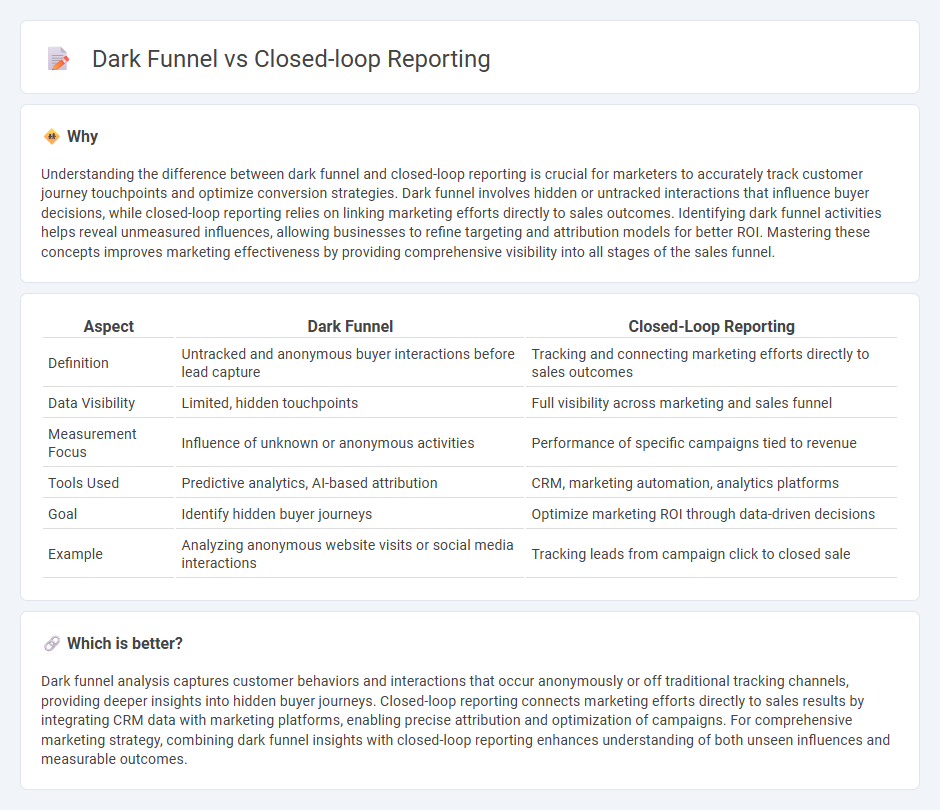
Dark funnel marketing involves tracking anonymous user interactions across multiple touchpoints before they become identifiable leads, revealing hidden consumer behavior and influence patterns. Closed-loop reporting connects marketing efforts directly to revenue outcomes by linking leads to their source campaigns, enabling precise ROI measurement and campaign optimization. Explore more to understand how integrating dark funnel insights with closed-loop reporting transforms marketing strategy effectiveness.
Why it is important
Understanding the difference between dark funnel and closed-loop reporting is crucial for marketers to accurately track customer journey touchpoints and optimize conversion strategies. Dark funnel involves hidden or untracked interactions that influence buyer decisions, while closed-loop reporting relies on linking marketing efforts directly to sales outcomes. Identifying dark funnel activities helps reveal unmeasured influences, allowing businesses to refine targeting and attribution models for better ROI. Mastering these concepts improves marketing effectiveness by providing comprehensive visibility into all stages of the sales funnel.
Comparison Table
| Aspect | Dark Funnel | Closed-Loop Reporting |
|---|---|---|
| Definition | Untracked and anonymous buyer interactions before lead capture | Tracking and connecting marketing efforts directly to sales outcomes |
| Data Visibility | Limited, hidden touchpoints | Full visibility across marketing and sales funnel |
| Measurement Focus | Influence of unknown or anonymous activities | Performance of specific campaigns tied to revenue |
| Tools Used | Predictive analytics, AI-based attribution | CRM, marketing automation, analytics platforms |
| Goal | Identify hidden buyer journeys | Optimize marketing ROI through data-driven decisions |
| Example | Analyzing anonymous website visits or social media interactions | Tracking leads from campaign click to closed sale |
Which is better?
Dark funnel analysis captures customer behaviors and interactions that occur anonymously or off traditional tracking channels, providing deeper insights into hidden buyer journeys. Closed-loop reporting connects marketing efforts directly to sales results by integrating CRM data with marketing platforms, enabling precise attribution and optimization of campaigns. For comprehensive marketing strategy, combining dark funnel insights with closed-loop reporting enhances understanding of both unseen influences and measurable outcomes.
Connection
The dark funnel represents the hidden customer interactions and touchpoints that occur before a lead enters the visible marketing and sales pipeline, often obscured from traditional analytics. Closed-loop reporting connects marketing efforts with sales outcomes by tracking leads through every stage of the funnel, linking marketing activities to revenue generation. Integrating dark funnel insights into closed-loop reporting enhances attribution accuracy and empowers marketers to optimize strategies based on comprehensive customer journey data.
Key Terms
Attribution
Closed-loop reporting tracks customer interactions from initial touchpoints through conversion, enabling precise attribution by linking marketing efforts directly to sales outcomes. Dark funnel refers to the untraceable or hidden stages in the buyer's journey, where data is fragmented or missing, making attribution challenging. Explore how advanced attribution models can bridge these gaps and improve marketing ROI.
Data Visibility
Closed-loop reporting enhances data visibility by tracking customer interactions from initial touchpoints to final conversions, enabling precise attribution and sales feedback integration. The dark funnel represents the untraceable, anonymous interactions in the buyer's journey that traditional analytics often miss, creating gaps in data accuracy. Explore how improving data visibility bridges these insights for more effective marketing strategies.
Lead Source Tracking
Closed-loop reporting enables marketers to precisely track lead sources by connecting marketing efforts directly to sales outcomes, providing clear ROI insights. In contrast, the dark funnel represents hidden buyer behaviors and touchpoints that are difficult to capture with traditional tracking, obscuring full attribution. Explore effective strategies to bridge the gap between closed-loop reporting and dark funnel visibility for enhanced lead source tracking.
Source and External Links
What is Closed-loop Reporting? - Optimal Digital Marketing - Closed-loop reporting is a process that integrates marketing and sales data in real time to enable smarter, data-driven decision-making, aligning both teams and improving ROI by continuously optimizing strategies based on clear revenue signals.
Closed-Loop Reporting and Why It Matters to Your Company - Closed-loop reporting involves marketing and sales sharing data to create better quality leads and maximize budgets by providing both teams with a full view of the sales funnel, improving lead qualification and shortening sales cycles.
The Basics of Closed-Loop Reporting - New Breed Marketing - Closed-loop reporting "closes the loop" between marketing automation data and sales CRM data, enabling marketers to leverage customer insights effectively and make strategic decisions like focusing on high-quality lead sources.
 dowidth.com
dowidth.com